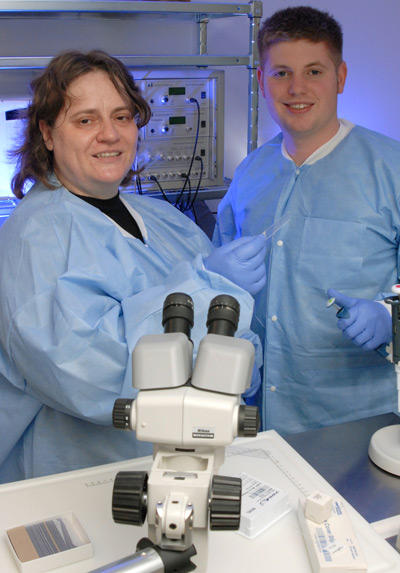Research News
UH Researcher Designs Novel Model for Studying Cardiovascular Disease
Tikunova's NIH-funded Project Examines Role of Protein Mutation in Dilated Cardiomyopathy

Faculty researcher Svetlana Tikunova and lab assistant Nathan Egge are studying the possible role of a cardiac protein mutation in the development of potentially fatal form of heart disease that causes cardiac muscle to enlarge and weaken over time.
A novel “knock-in” mouse model designed by UHCOP Assistant Professor Svetlana B. Tikunova, Ph.D., may yield clues into how mutations in a key cardiac protein can lead to dilated cardiomyopathy (DCM), one of the most common forms of heart disease.
Tikunova’s exploration into the molecular mechanisms of DCM is supported by a new three-year, $451,166 grant from the National Institutes of Health’s National Heart, Lung, and Blood Institute.
In DCM, the heart’s main pumping chamber (the
left ventricle) becomes enlarged and weakened, reducing its ability to adequately pump blood to the rest of the body. The most common form of disease affecting the heart muscle, DCM is a life-threatening condition that can lead to blood clots, irregular heartbeats (arrhythmia), congestive heart failure and sudden death. It can affect individuals of any age, including children, as well
as many breeds of dogs.
Although the causes for all DCMs have not been identified, known causes include congenital heart disease, toxins, thyroid disease, inflammatory conditions, infections, severe long-standing hypertension, radiation and hereditary factors.
Up to 40 percent of DCM cases are believed to be caused by mutations in cytoskeletal and sarcomeric proteins, but how these mutations lead to the development of the disease is unclear.
Tikunova’s project will explore the role of mutations that alter calcium sensitivity of the cardiac troponin C in the development of cardiomyopathies. Cardiac troponin C (cTnC) is a regulatory protein, whose calcium-binding function is integral to cardiac-muscle contraction.
The cTnC mutation was engineered to desensitize cTnC to calcium and was introduced into mouse myocardium via gene targeting technology in order to recreate the phenotype of DCM.
“Our goal is to gain a better understanding of how mutations of regulatory proteins affect molecular signaling of calcium-binding and exchange, which impacts the heart muscle’s normal function,” Tikunova said. “This engineered cTnC mutation results in reduced calcium sensitivity and a faster rate of calcium dissociation from thin filaments in the heart muscle. If our knock-in mouse model then develops DCM, we can demonstrate a link between calcium desensitization of cardiac muscle and the development of DCM.”
Fellow UHCOP cardio-pharmacology faculty member Bradley McConnell is a co-investigator on the project.